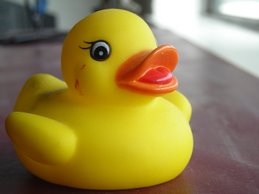open vs. closed text
I've been thinking a lot about open versus closed text since yesterday (mostly due to insomnia), and I've come to the conclusion that it is impossible to fully separate the two. To me, it seems like they are intrinsically linked, and neither can exist without the other. I believe that no text can be absolutely open or absolutely closed.
Text cannot be fully closed, because words can never be precise enough thoroughly convey the ideas of the writer. As Stein suggests, words are merely the names of objects, not the objects themselves. As such, they will always be open to some amount of interpretation.
Say, for example, I want to write a poem about a chicken. The word “chicken” is obviously not a real chicken, but merely a symbol meant to excite the region of the brain designated for storing all things chicken-related. Due to the fact that everyone has had a slightly different experience regarding chickens, we will all have a different chicken prototype. Presented with the chicken symbol, we are left with a slough of unanswered questions. What does it look like? What does it smell like? How does it move? What would it do if I kicked it? The only way to be completely closed is to present each reader with an actual chicken in the place of its name. Needless to say, this would be very impractical. You would have to give up poetry and become a very busy poultry farmer (not that there’s anything wrong with farmers). As you can imagine, accurately portraying abstract concepts would be infinitely more difficult (∞ × impossible=?). So, to some extent, text will always be open.
On the other hand, text cannot be entirely open. Every word will guide the reader in one direction, while excluding others. Presented with the words “nipple” and “ferret,” the reader is unlikely to include “subway” and “rainbow” into his interpretation (unless he is unusually strange), because the latter words have nothing to do with the former.
The only way to give the reader absolute freedom of interpretation is to remove the words altogether. Now, this poses an even bigger problem. If the reader is given nothing, then they won’t have anything to interpret. Nothing is absolute. Nothing can never be open. Practically speaking, nothingness can never be poetry, because it lacks text.
Text can neither be fully open or fully closed, because they are not mutually exclusive. They are not opposites. In fact, it seems that they are entirely dependent on each other. Without being both open and closed, poetry cannot exist. Given this, the best we can do is find a healthy balance between the two.

1 comment:
Great post, Sarah!
"Presented with the words 'nipple' and 'ferret,' the reader is unlikely to include 'subway' and 'rainbow' into his interpretation (unless he is unusually strange), because the latter words have nothing to do with the former."
Now they do! Thanks to you.
The "balance" you speak of striving for: this is related to the notion of the asymptotic that we were talking about, I think. Except that rather than a balance, one might think of it as a perpetual closing-in-on a perpetual opening-up: an infinite suspension or hiatus. "Balance" still implies that there are determinate limits on either side of the midpoint, whereas the asymptotic motion is one in which such limits are only ever conceptual at best. In a situation involving balance, the risk is that the object falls to one side or the other; in the trajectory of the asymptotic curve, the risk is that one mistakes one's closeness for contact, and tries to treat what is and must continue to be open as though it were closed. Or, I suppose another risk is that one despairs at the infinite quality of the open and falls back on ... what? More openness.
Post a Comment